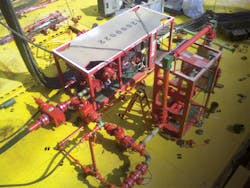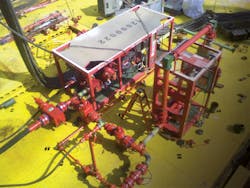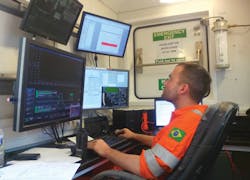MPD solution helps maintain wellbore integrity, reduce NPT
Application employed on drilling campaign offshore Asia
Scott Miller,Halliburton
Ona recentjob in the Asia/Pacific region, Shell identified the need for a managed pressure drilling (MPD)/managed pressure cementing (MPC) solution on two water injection wells. The solution was needed to maintain constant bottomhole pressure while drilling a narrow pressure margin in the 10-5/8-in. x 12-in. section.
Previous drilling efforts in this section had encountered issues with borehole instability and weak, faulted sand structures. It was also determined through further analysis of previous non-productive time (NPT) and pressure-related events that the 8½-in. reservoir sections would benefit from MPD constant bottomhole pressure techniques.
The MPD choke and Coriolis meter as installed on the rig. (Courtesy Halliburton)
Narrow margins
Planning was critical to minimize operational risks and optimize drilling efficiency on this MPD/MPC job. Halliburton worked closely with Shell to generate detailed modeling and develop a thorough execution plan for successful navigation through the narrow margins expected.
By adjusting the static mud weight, at times up to one pound per gallon under the conventional drilling target weight, the MPD crew had the surface pressure flexibility to manipulate bottomhole pressure (BHP) and confidently maintain borehole stability. The plan also included a strategy for staying within the BHP window during tripping in and out of the hole, and for running casing and cementing operations.
Employing a patented surge and swab pressure compensation feature during tripping pipe and, more importantly, while running the 9-5/8-in. liner into the open hole, enabled the crew to maintain a constant BHP in these critical operations.
Additionally, a dual gradient tripping strategy of spotting a highly viscous pill with a heavier kill mud on top allowed operations to keep the lighter mud in the hole, without needing to displace the entire system to kill weight mud. This approach saved time and ensured that the proper BHP was attained while tripping pipe, and while switching from drilling to cementing operations.
Once the plan was solidified and the equipment installed and ready for operation, the MPD team spent time training all other parties directly involved in the project. This served to familiarize the crews with operational differences with conventional drilling practices, and the communication protocol required when making connections.
Real-time information provided by the GeoBalance solution helps crews maintain constant bottomhole pressure. (Courtesy Halliburton)
Drilling to depth
The MPD/MPC control system was configured to receive data from several ancillary sources for the best possible pressure control downhole. Fingerprinting, or validating, the system’s actual behavior with the model and conducting mock operations in the 12¼-in. section served as a valuable final check of the system’s control response and helped solidify procedures during the actual MPD operations. The two wells were batch drilled, with a 2,214-ft, 10-5/8-in. x 12-in. section drilled on the first well and a 1,465-ft, 10-5/8-in. x 12-in. section drilled on the second well. After drilling, the bottomhole assembly was pulled back to the shoe and the high viscous pill was spotted.
Above the pill, the drilling fluid was displaced with a 1.1 ppg heavier mud. Static flow checks were performed before pulling the RCD and preparing to run the liners. The 9-5/8-in. liners for both wells were run to total depth (TD), rolling over the fluid back to the lighter mud when the shoe was reached with the liner.
MPC technology was successfully utilized to cement the 9-5/8-in. liners on both wells in order to maintain ECD above the sand stringer pore pressure, while avoiding losses to weak shale/faulted zones. GB Setpoint, the Halliburton real-time hydraulics model, was an important asset during both the MPD and MPC operations. By incorporating real-time data, tracking multiple fluids in the wellbore and accounting for surge and swab while running the liner, the crew was able to successfully navigate a narrow window within 0.2-0.3 ppg of the target BHP. Once both 10-5/8-in. sections were drilled and cemented, the 8½-in. section on the second well was drilled another 1,865 ft to TD, and the 8½-in. section on the first well was drilled another 2,698 ft to TD, where the wells were then completed. Brief dynamic losses were encountered while initially drilling the first 8½-in. hole, which were remedied by reducing the rate of penetration (ROP) and revising the ECD target down 0.1 ppg.
Avoiding NPT
Using experienced and competent crews, along with the appropriate technology, Halliburton and Shell collaborated to successfully execute a safe drilling campaign. Halliburton helped the operator avoid two weeks of NPT related to borehole stability, reservoir influxes and losses, controlling the BHP at the critical point in the well during drilling operations, including tripping and running and cementing the liner. This operation for Shell in Asia/Pacific is expected to pave the way for similar operations in this region and beyond. •


